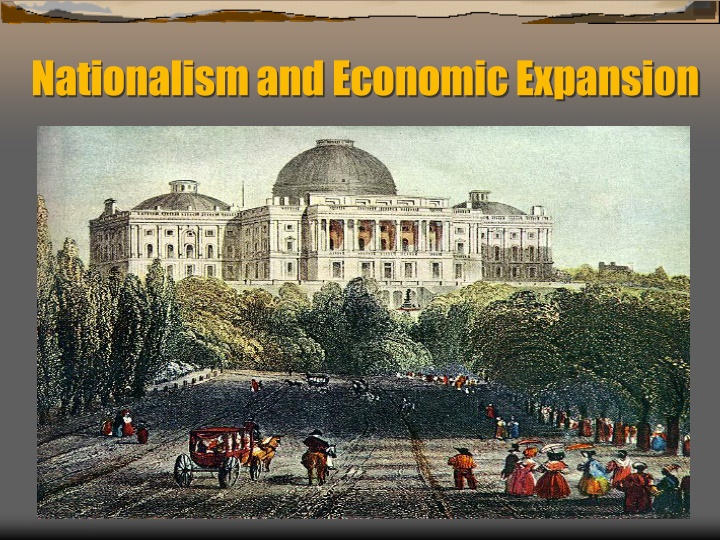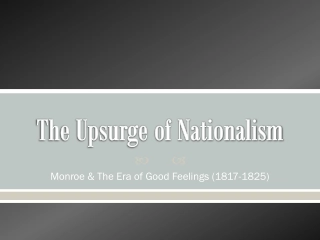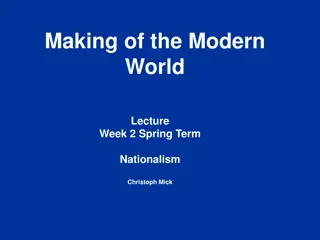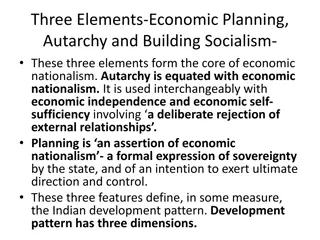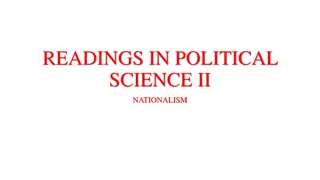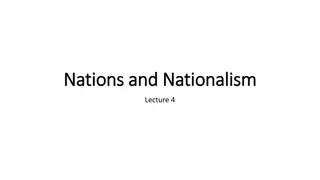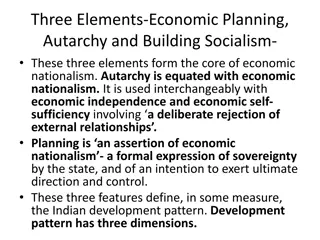Nationalism and Economic Expansion During the Era of Good Feelings
The content discusses the impact of nationalism and economic expansion in the United States during the Era of Good Feelings. It covers topics such as the disruption in Atlantic shipping, factors contributing to the Industrial Revolution, political developments after the War of 1812, and the implementation of Clay's American System. The narrative also highlights the Supreme Court's role in promoting nationalism through key rulings. Additionally, it explores the expansion of national boundaries through diplomatic relations, including the acquisition of Florida through the Adams-Onis Treaty.
Uploaded on Feb 26, 2025 | 3 Views
Download Presentation

Please find below an Image/Link to download the presentation.
The content on the website is provided AS IS for your information and personal use only. It may not be sold, licensed, or shared on other websites without obtaining consent from the author.If you encounter any issues during the download, it is possible that the publisher has removed the file from their server.
You are allowed to download the files provided on this website for personal or commercial use, subject to the condition that they are used lawfully. All files are the property of their respective owners.
The content on the website is provided AS IS for your information and personal use only. It may not be sold, licensed, or shared on other websites without obtaining consent from the author.
E N D
Presentation Transcript
Jump Start Factors Contributing to the Industrial Revolution in the United States How did the disruption in Atlantic shipping prior to and during the War of 1812 significantly affect the U.S. economy? The flow of imported goods is cut off during the War of 1812. Manufacturers invest in industrial technology. River water provides power to run factory machines. ? A Imports of raw materials increased in the Northeast. B Americans emigrated to Europe to find manufacturing jobs. C Cotton sales from southern states to Europe increased. D American industries expanded to provide replacements for foreign goods. Which of the following best completes the table above? A Immigration expands the labor force. B The government seizes control of factories. C Overland trade routes become obsolete. D A scarcity of raw materials causes prices to rise.
James Monroe 5thPresident VA Democratic-Republican Madison s Secretary of State With Federalist collapse after War of 1812, no political struggles for power
Era of Good Feelings Period characterized by lack of political disruption and economic growth Nationalism spread Nationalism- pride toward one s country People started shifting loyalty toward the federal government
Clays American System Wanted the U.S. to be economically self- sufficient: Established a protective tariff- made foreign goods more expensive Established a national bank- would promote a single currency and make trade easier Improved the country s transportation system
Supreme Courts helps Nationalism McCulloch vs. Maryland Maryland wanted to tax its branch of the national bank If allowed, states could claim power of the national govt Court said NO! Promoted unity by strengthening the federal government Gibbons vs. Ogden Two steamship operators fought over shipping rights on the Hudson River in NY and NJ Court ruled that interstate commerce could only be regulated by the federal govt Stronger federal government reflected growing nationalism VS
Growing National Boundaries Relations with Spain were tense Disagreed over boundaries Runaway slaves used Spanish owned east Florida as a refuge Indians in east Florida were raiding Georgia Monroe sent Andrew Jackson to stop raids Jackson ended up claiming all of Florida for the U.S. Monroe told him to leave but gave Spain a choice: police Florida or give it to us Adams Onis Treaty (1819) Spain gave the U.S. Florida No longer claimed Oregon Now only claimed by Britain and U.S.
Sectionalism Grows Sectionalism: loyalty to the interests of your own region rather than the country as a whole Economic changes led to different interests and needs among the North, South, and West These interests often were in conflict North- wealth based on manufacturing and trade South- plantation system and cotton West- wanted cheap land and good transportation system
Missouri Compromise (1820) Missouri applies for statehood 1819 Wants slavery to be allowed 11 free and 11 slave states currently Missouri would ruin the balance South would have more power in Congress Maine admitted with Missouri as a free state Slavery banned in future territories north of 36 30 Henry Clay led compromise
Monroe Doctrine (1823) Latin American countries had gained independence from Spain and Portugal Some European monarchs planned to help them get their colonies back U.S. felt threatened Doctrine stated that: Americas were closed to European colonization U.S. would stay out of European affairs Showed that U.S. considered itself a world power
